When we look at the process of lightning and lightning when it rains, we may not realize that at that moment there is a 'jump' of some static electricity charge, ie electrons. The occurrence of electric jumps in the form of lightning and lightning brings this enormous energy so very reasonable when the occurrence of lightning and lightning is very feared because buildings or people affected by lightning strikes will generally burn. To protect from the danger of lightning and lightning, the high buildings are generally equipped with lightning rods.

Electricity is one form of energy. Electrical energy has become an important part of human life. Electricity is basically divided into two kinds, namely static electricity and dynamic electricity. Static electricity is related to electrical charges in a stationary state, while dynamic electricity is related to electrical charge in a moving state.

Electrical charge
Static electricity (electrostatic) discusses electrical charges that are in a state of silence (static). Interesting attraction between two objects such as plastic ruler and small piece of paper can be explained using the concept of electric charge.
Based on the concept of electric charge, there are two kinds of electric charge, that is positive charge and negative charge. Electrical charges arise because of the electrons that can move from one object to another. Objects that lack electrons are said to be positively charged, while objects with excess electrons are said to be negatively charged. Electrons are the basic charge that determines the electrical properties of an object.
The Nature of the License
- Two similar charges when brought near it will refuse refuse
- Two unrelated payloads when pulled closer will draw
Coulomb Style (Coulomb Law)
Coulomb Style between Two Point Charges
In 1785, Charles Agustin Coulomb discovered the basic law of the electric force between two charged particles.
The result of his research is known as the Law of the Coulomb, which reads: "The magnitude of the attraction force (similar electrical charge) or refuse (unlike electrical charge) between two electrically charged objects is proportional to the respective charge and is inversely proportional to the square of the distance between the two objects ".
Mathematically Newton's Law is written:

with:
F = The pull / duty force of two payloads (N)

Q1, Q2 = electrical charge (C)
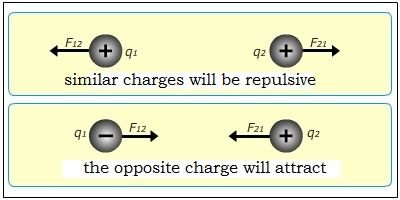
A few important notes about the Coulomb Law equation are that the equation:
- Applies only to point charges (meaning the volume dimension is not considered).
- The constant value of 9 x 109 N m2 C-2 applies only to charge in vacuum or air, for other mediums the price will be different.
- If q and q 'are marked the same then F will be positive. A positive F indicates that both charges refuse. On the contrary a negative sign indicates an attractive style.
- The electrostatic force F is the vector quantity, so the operation on it must satisfy the operating conditions on the vector quantity. This means that if there is some charge, the total force experienced by one charge is the resultant of the superposition of forces by other charges.
Coulomb Style Segaris Loads
The magnitude of the Coulomb force on a charge that is affected by some similar charge is directly summed in vectors. The Coulomb force at charge q1 is affected by the charge q2 and q3 is F = F12 + F13. If the direction to the right is considered positive and the direction to the left is negative, the Coulomb force on the load:
F = F12 + F13 + ….

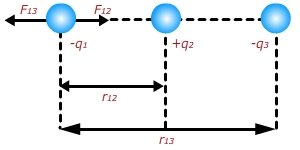
Coulomb Style The charges are not in line
The Coulomb force for the three q1, q2, q3 on the charge q1 can be found using the cosine formula as follows.
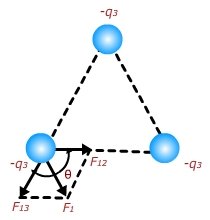
F1 = 
F12 =k  F13 =
F13 = 
Powerful Electric Field
An electrically charged object is surrounded by an area called an electric field. To visualize an electric field, it is done by drawing a series of lines to indicate the direction of the electric field at various points in space, called electric field lines.
The properties of electric field lines
- Electric field force lines never intersect one another.
- Electrical field force lines always point radially outward from positive and radial charges into the negative charge.
- Places where the lines of electric field force tightly denote a strong electric field; on the contrary the place where the stretching electric field lines indicates a weak electric field.
Electrical field lines (a) for two positive charges, (b) for positive charge and negative charge
.jpg)
1). Gauss's Law
We can declare Coulomb's Law in another form, called Gaussian Law, which can be used to calculate electric field strength in certain symmetric cases.
Gauss's law states that "the number of algebraic lines of magnetic force (flux) of electricity penetrating a closed surface is proportional to the number of algebraic electrical charges within the surface".
Flux corresponds to the magnitude of the "penetrating" field in a direction perpendicular to a particular surface. The electric flux denotes an electric field penetrating in the direction perpendicular to a surface. electric fluxes can be described as the number of "lines" of the field penetrating a surface.
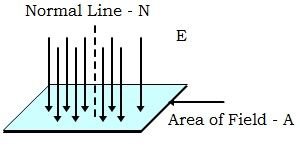
Electrical flux is defined as the multiplication of electric field (E) with the extent it passes (A):
Φ = E . A
Note :
Φ= electric flux (N m2/C)
E = electric field
A = area (m2)
If the electric field lines penetrating a plane have an angle then the electric flux formula is as follows:
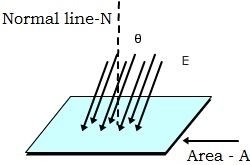

 =Electric Flux (Weber)
=Electric Flux (Weber)
E = Strong Electric Field (N / C)
A = Area of Area (m2)
Θ = angle between E with normal line
Powerful electric field due to a charge
The measure of the strength of the electric field at a point, defined as the force per unit charge on the electrical charge placed at that point, is called the electric field strength (E). Mathematically strong electric field is written:

E = Electric field strength (N / C)
F = Coulomb style (N)
q = electric charge (C)Strong electric field on Condutor plate
On two parallel pieces having the same electrical charge, but opposite the type, between the two pieces there is a homogeneous electric field. If the area of A, each chunk is loaded with q and -q, the electric field is represented by the number of lines of force, whereas the force lines are expressed as the amount of charge which gives rise to the line of force (Gauss' Law). The electric charge per unit of the area of the conducting chips is defined as the surface charge density given the symbol σ (sigma), as measured in C / m2. The electric field strength between the two parallel pieces is:

E = electric field strength (N / C)
σ = density of chip (C/m2)
ε0 = permittivity of free space = = 8,85× 10-12 C/Nm2
- Strong electric field on Hollow Conductor Ball
On a closed surface eg a total flux ball passing through a closed surface is expressed as:


The electric field in any place on this surface is perpendicular to the surface. The magnitude of the electric field is:


Potential Electricity and Potential Electricity Energy
a. Potential Electricity
In the concept of electric field is distinguished between the sense of electric potential (V) with electrical potential energy (Ep). Consider the following illustration:

Electrical potential at point P
A source charge generates an electric field at any point in the spherical sphere around it. For example in point A which is R distance from charge.
The electric potential (V) is at point A because the charge q is defined as:

The potential at a point, for example point A above (which is usually called absolute potential) is the difference or potential difference between the potential at that point with a point so far that its potential is zero, so we can get a price that is closest to the potential price "in fact". This very long distance reference point is chosen as a general reference because it has a near zero potential, as the analogy in gravity potential we choose the surface of the earth as a general reference because its potential is zero.
b. Potential Electricity Energy
There is a certain energy that comes from a negative charge that makes a positive charge attracted or "falls" to it. This energy is called the electrical potential energy. The electric potential energy is defined as "the effort (work) required to move the charge q 'from A to B". To understand the meaning of electric potential energy and electrical potential physically, we re-analogize the gravitational potential energy. Earth's gravitational force pulls an object toward the surface of the earth. Both the gravitational force of the earth (F) and the strength of the gravitational field (acceleration of gravity g) downward vertical bearah. Jia an object raised that occurs is against the force of gravity, it means we make an effort on the object and as a result the potential energy (Ep) object gravity increases.
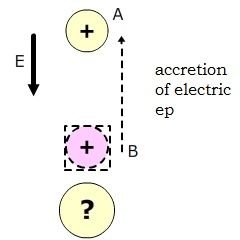
The electric field generated by the electric charge q, to move the charge of q 'from point A spaced rA to point B rb from q. The effort required is:

In this case the electric potential energy is negatively marked, which means the further away from the electric field the greater the potential energy. The magnitude of the electrical potential energy at infinity is equal to zero. If point A is far infinitely rA, then EPA = 0 and the equation above becomes:

In this case rB can be any distance, then:

Sources :
This takes me all the way to high school, lol. Electric field and magnetic fields. Feels good to know there's people who are still passionate about science